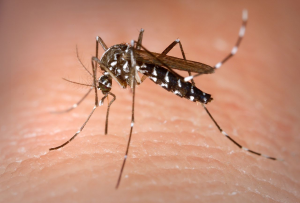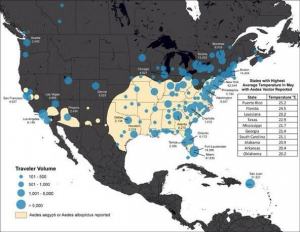by Hannah Hoag and Kasra Hassani
Medicine and Veterinary Science subject editors
What emerging infectious disease are you most worried about? You may think that here in Canada we’re far from the threat of infectious diseases that originate in warm southern climes, but climate change could bring that threat into our backyard.
Last month, at the annual meeting of the American Society for Microbiology, Dr. Lyle Petersen of the U.S. Centers for Disease Control and Prevention singled out chikungunya as an infectious disease to worry about. Although you’ve probably never heard of this mosquito-transmitted virus, it is presently on a rampage through the Caribbean–the first time it’s been transmitted locally, from one person to another and on to the next–and it’s poised to spread.
Petersen predicts “explosive large outbreaks in tropical America.” Puerto Rico and the U.S. Virgin Islands are at high risk for outbreaks, and there’s a good chance that thousands of travel-associated cases will be brought into North America.
Until late last year, chikungunya had been a disease restricted to Asia and Africa. Then, in October, family doctors on the French half of the Caribbean island St. Martin began hearing of people complaining of rash, joint pain, and fever. It looked a little like dengue fever, a viral disease spread by mosquitoes that occurs in the area every year. But something wasn’t quite right.
Samples were sent to the French National Reference Centre for arboviruses in Marseille, where genetic tests confirmed they had several cases of chikungunya virus infection on St. Martin. By mid-May, the virus had spread to 14 countries in the Caribbean, infecting 51,000 people. Today, more than 100,000 cases have been reported.
The chikungunya virus is primarily transmitted by a mosquito species called Aedes aegypti, but another mosquito species, Aedes albopictus, also known as the Asian tiger mosquito, can also transmit the disease. One version of the virus in particular sports a single mutation that makes it ultra-efficient at infecting the Asian tiger mosquito, and that’s what has public health experts in North America worried.

A female Aedes albopictus mosquito obtains a blood meal from a human host. Credit: James Gathany, CDC.
The Asian tiger mosquito loves warmer, wetter environments, and climate change has brought just enough of a shift to allow it to make itself comfortable farther north. The tiger mosquito arrived in the Port of Houston roughly 25 years ago in a shipment of tires from Japan and has since spread through 36 states, slowly heading northward to reach the edge of New York City.
Could it spread to Canada? We haven’t got it yet, Nick Ogden of the Public Health Agency of Canada, told the meeting. But in the future “it’s possible that southern Ontario, southern Quebec, the Maritimes, and southern British Columbia might be suitable,” he said.
For now, public health officials in the U.S. and Canada are bracing for the influx of thousands of travel related cases of chikungunya. A study published in early June in PLOS Currents Outbreaks, by Kamran Khan at the University of Toronto and colleagues, found that 52% of flights leaving the Caribbean landed in the U.S., particularly New York City, Miami, and San Juan (Puerto Rico). And if the mosquito populations in those regions dine on the blood of enough infected travellers, seasonal outbreaks of chikungunya could become the new normal.

Figure from: Khan K, Bogoch I, Brownstein JS, Miniota J, Nicolucci A, Hu W, Nsoesie EO, Cetron M, Creatore MI, German M, Wilder-Smith A. Assessing the Origin of and Potential for International Spread of Chikungunya Virus from the Caribbean. PLOS Currents Outbreaks. 2014 Jun 6. Edition 1. doi: 10.1371/currents.outbreaks.2134a0a7bf37fd8d388181539fea2da5.
Many people think of climate change as an event of the future, a phenomenon for the next generation to manage. Unfortunately, climate change is already causing environment- and health-related impacts across the planet.
In addition to chikungunya, world health officials worry about the health impacts of extreme weather conditions (drought, extreme heat, heavy rainfall, and flooding), which could boost outbreaks of diarrheal disease should clean water become scarce. Other climate-sensitive infectious diseases, such as dengue, malaria, and yellow fever, may spread into new niches, as the climate becomes more favourable for the mosquitoes to reproduce. As the planet’s climate changes, infectious diseases are changing their footprints as well – and Canada is not immune.





One thought on “Climate change and the northward spread of infectious diseases”
Comments are closed.